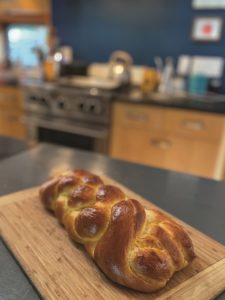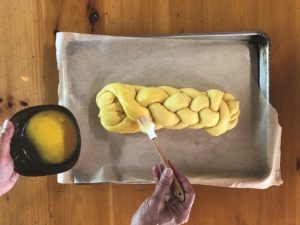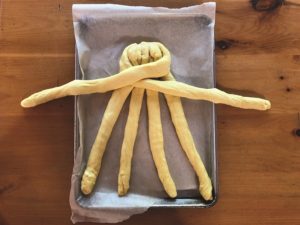We’re coming up on the high holy days of the Jewish calendar. Rosh Hashanah, the Jewish new year, which starts at sundown on Sunday the 25th, signals the start of a 10-day period of reflection, self-examination, and repentance — the Days of Awe.
It ends with Yom Kippur, a day of fasting and atonement, considered the holiest day of the year, this year beginning at sundown on Oct. 4.
The biblical name for Rosh Hashanah is Yom Teruah, literally “day of shouting or blasting,” and the high holidays are famous for the repeated blasts of the shofar, or ram’s horn. As with almost all Jewish rituals, it seems, the meaning of this one is complex. The sound of the horn is said to be, in different ways, celebratory, mournful, rousing, and startling. Rabbi Moses Maimonides said that its meaning was “Wake up, sleepers, from your sleep, and you slumberers from your slumber. Examine your souls and improve your ways and your motivations.”
At every Jewish holiday, of course, food is of paramount importance. Perhaps the most beloved Rosh Hashanah tradition is eating apples with honey — symbols of hope for a sweet and fruitful year.

The apple is also an ancient Jewish symbol of love and desire, as in the Song of Solomon: “Like an apple tree among the trees of the forest is my lover among the young men. I delight to sit in his shade, and his fruit is sweet to my taste. He has taken me to the banquet hall, and his banner over me is love. Strengthen me with raisins, refresh me with apples, for I am faint with love.”
My parents were raised in strict Jewish households, but they rejected formal religion as adults and so we didn’t celebrate Rosh Hashanah. Now I wish things had been a little different. There was not much self-examination at our house and, as for atonement, fuhgeddaboudit. If there was shouting, it was my mother calling my father a paskudnyak.
The high holiday table wouldn’t be complete without challah, the braided, eggy sweet bread eaten on the sabbath. My mother didn’t make bread, and when she sometimes brought home a challah from Butterflake, the Jewish bakery in Teaneck, it looked good but was disappointingly dry and dull. So it wasn’t until a few years ago, after my experiments with reproducing the sour rye from Gratzel’s, the other Teaneck bakery, that I decided to try my hand at challah.
My go-to recipe, adapted from one by Melissa Clark in the New York Times, uses olive oil and tangerine juice and makes a loaf that is aromatic, rich, and zesty. One tradition says the Rosh Hashanah challah should be round, to symbolize the cycle of the year being completed. Clark’s recipe includes instructions for making a braided round loaf with three ropes of dough.
I prefer the more elaborate long loaf made with six ropes. The braiding pattern is strangely hard to remember; I have to look it up every year. But it makes a challah that is perfect the next day for making sandwiches with that leftover brisket (or, as is the custom in our mixed-cultural- background household, with — shhhh! — slices of ham).
If you don’t have a shofar handy, this challah will give you a reason to shout.
New Year’s Challah
Makes one loaf
½ cup tangerine juice at room temperature
2¼ tsp. active dry yeast
1/3 cup extra virgin olive oil
3 large eggs at room temperature
1 large egg yolk at room temperature
3 Tbsp. sugar
1 tsp. kosher salt
½ tsp. grated lemon zest
3 to 3½ cups bread flour, plus more for kneading

Place tangerine juice and one tablespoon of warm water in the bowl of an electric mixer fitted with the dough hook. Sprinkle in yeast, and let it proof until frothy, about 10 minutes. Add the olive oil, 2 eggs, 1 egg yolk, sugar, salt, and lemon zest, and beat to combine. Add the first two cups of flour one cup at a time. Add the last cup to cup and a half more slowly, beating it in until the dough comes together in a sticky mass. It should come away from the sides of the bowl but not be stiff. You want a slightly sticky and soft dough.
Knead the dough on a floured surface until it is smooth, about 5 minutes. Then place it in a bowl and coat it with olive oil. Cover the bowl, put it in a draft-free spot, and let dough rise until it has doubled in size. This might take as long as 3 hours. Press the dough down gently, cover, and let it rise again for another 45 minutes.
Mix the remaining egg with a teaspoon of water — this is the egg wash that will make the bread glossy — and set it aside.
Cut the dough into 6 equal pieces and roll them into ropes at least 16 inches long. To braid the loaf, arrange the ropes in a fan shape with the top ends pressed together. Start with the rope on the far right and bring it all the way across the other ropes to the outer left side. Then take the rope just to its right (which was the one on the outer left at the start) and bring it across to the outer right. Spread the six strands out evenly.

Now take the rope on the outer left and bring it to the middle, then pick up the second rope from the outer right and make it the outer left. Continue this pattern from the other side: place the outer right strand in the middle and replace the outer right by using the second strand from the left. When you’ve braided as far as the strands will allow, pinch their ends together and tuck them under the loaf.
Place the loaf on a rimmed baking sheet lined with parchment paper. Brush with the egg wash and let rise for 45 minutes.
Meanwhile, heat the oven to 375 degrees. Gently brush a second coat of egg wash on the loaf and bake for 25 to 35 minutes. The challah should be deep brown. Tap the bottom; it should sound hollow. Cool on a rack before serving.
